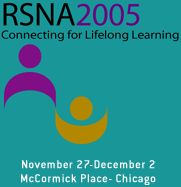
Abstract Archives of the RSNA, 2005
LPR03-03
Quantitative Pulmonary Perfusion MRI in Pulmonary Hypertension: Correlation of Perfusion Parameters to Hemodynamic Measurements from Right Heart Catheterization
Scientific Posters
Presented on December 1, 2005
Presented as part of LPR03: Chest (MR Perfusion, Technique)
Christian Fink MD, Presenter: Nothing to Disclose
Joachim Meyer MD, Abstract Co-Author: Nothing to Disclose
Frank Risse, Abstract Co-Author: Nothing to Disclose
Christian Vollmer, Abstract Co-Author: Nothing to Disclose
Sebastian Ley MD, Abstract Co-Author: Nothing to Disclose
Hans-Ulrich Kauczor MD, Abstract Co-Author: Nothing to Disclose
Previous studies have demonstrated significant differences of pulmonary perfusion MRI between normal volunteers and patients with pulmonary hypertension (PH). However, the correlation of pulmonary perfusion MRI with conventional catheter measurements of the pulmonary hemodynamics in PH is still unknown. The purpose of this study was to evaluate the correlation of perfusion parameters obtained by MRI to hemodynamic parameters obtained from right heart catheter measurements.
20 patients with PH (median age: 62 years; chronic thromboembolic PH: 8; primary PH: 12) were examined with contrast-enhanced 3D pulmonary perfusion MRI (FLASH; TE/TR/α=0.8 ms/1.9 ms/40°; GRAPPA; PAT=2; temporal resolution: 1.5 s). Pulmonary perfusion (pulmonary blood flow (PBF), blood volume (PBV), and mean transit time (MTT)) was quantified using deconvolution and indicator dilution theory. In addition, the normalized mean peak signal intensity (ΔSI) and time-to-peak (TTP) were extracted from the signal intensity time courses of the lung. MR perfusion parameters were correlated to hemodynamic parameters (mean pulmonary artery pressure (PAP), pulmonary vascular resistance (PVR), and cardiac output (CO)) obtained from right heart catheter measurements.
There was only a poor correlation observed between perfusion parameters obtained by MRI and hemodynamic parameters from catheter measurements. For the PAP the best correlations were found with TTP (r=0.52), PBF (r=-0.48), and MTT (r=0.43). PVR showed the best correlation with PBF (r=-0.54), MTT (r=0.49), and TTP (r=0.48). CO correlated best with TTP (r=-0.41), PBF (r=0.37), and PBV (r=0.29).
Quantitative pulmonary perfusion MRI shows only a poor correlation to hemodynamic right heart catheter measurements. Potential reasons for these findings are that perfusion is not exclusively determined by right heart hemodynamics, as well as methodological problems of pulmonary perfusion MRI (signal linearity, dependence of inspiratory level, etc.) leading to wrong perfusion estimates.
Previous studies have demonstrated significant differences of pulmonary perfusion MRI between normal volunteers and patients with pulmonary hypertension (PH). However, the correlation of pulmonary perfusion MRI with conventional catheter measurements of the pulmonary hemodynamics in PH is still unknown. The purpose of this study was to evaluate the correlation of perfusion parameters obtained by MRI to hemodynamic parameters obtained from right heart catheter measurements.
20 patients with PH (median age: 62 years; chronic thromboembolic PH: 8; primary PH: 12) were examined with contrast-enhanced 3D pulmonary perfusion MRI (FLASH; TE/TR/α=0.8 ms/1.9 ms/40°; GRAPPA; PAT=2; temporal resolution: 1.5 s). Pulmonary perfusion (pulmonary blood flow (PBF), blood volume (PBV), and mean transit time (MTT)) was quantified using deconvolution and indicator dilution theory. In addition, the normalized mean peak signal intensity (ΔSI) and time-to-peak (TTP) were extracted from the signal intensity time courses of the lung. MR perfusion parameters were correlated to hemodynamic parameters (mean pulmonary artery pressure (PAP), pulmonary vascular resistance (PVR), and cardiac output (CO)) obtained from right heart catheter measurements.
There was only a poor correlation observed between perfusion parameters obtained by MRI and hemodynamic parameters from catheter measurements. For the PAP the best correlations were found with TTP (r=0.52), PBF (r=-0.48), and MTT (r=0.43). PVR showed the best correlation with PBF (r=-0.54), MTT (r=0.49), and TTP (r=0.48). CO correlated best with TTP (r=-0.41), PBF (r=0.37), and PBV (r=0.29).
Quantitative pulmonary perfusion MRI shows only a poor correlation to hemodynamic right heart catheter measurements. Potential reasons for these findings are that perfusion is not exclusively determined by right heart hemodynamics, as well as methodological problems of pulmonary perfusion MRI (signal linearity, dependence of inspiratory level, etc.) leading to wrong perfusion estimates.
Fink, C,
Meyer, J,
Risse, F,
Vollmer, C,
Ley, S,
Kauczor, H,
Quantitative Pulmonary Perfusion MRI in Pulmonary Hypertension: Correlation of Perfusion Parameters to Hemodynamic Measurements from Right Heart Catheterization. Radiological Society of North America 2005 Scientific Assembly and Annual Meeting, November 27 - December 2, 2005 ,Chicago IL.
http://archive.rsna.org/2005/4414589.html

